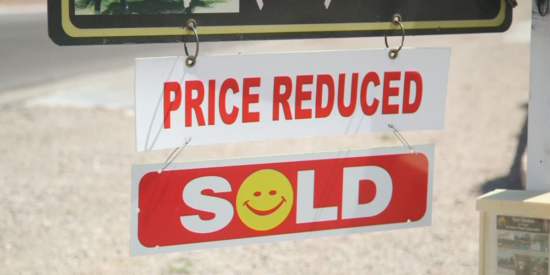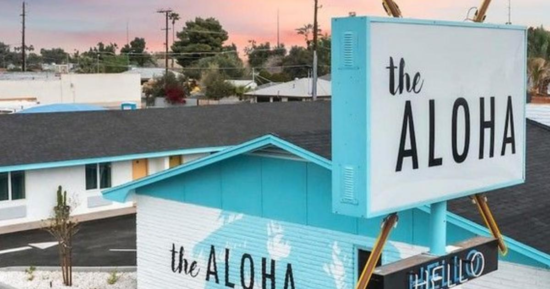Founded May 17, 1912, by Dr. A.J. Chandler and incorporated as a city in 1920, Chandler has more than a dozen historical properties and homes that are nested throughout Maricopa County and have also been listed in the National Register of Historic Places.
See some of the properties and homes representing Chandler’s Territorial history.
300 S. Chandler Village Drive
McCullough-Price House, built in 1938, is the current home of the Chandler Museum. Located next to the Chandler Fashion Center, this home is unlike typical Arizonan buildings. The 1938 Pueblo Revival-style home was built as the winter retreat location for Detroit resident William D. McCullough, who is the founder of the Premier Cushion Spring Co., which provided automobile parts to Dodge and Ford. Royal Lescher and Leslie Mahoney, Phoenix’s most famous architecture team, were hired by McCullough to design this home that featured projecting wooden roof beams, a faux adobe appearance, rounded corners, parapets, a rooftop patio and a walled courtyard, all characteristics of Southwestern style.
In 1950, the home was purchased by Arthur and Louise Price, and Louise was the niece of the city of Chandler’s founder, Dr. A.J. Chandler. In 2007, this building was included in the National Register of Historic Places, but it closed in 2009 during the declining economy. It was in 2012 when the building reopened as the headquarters of the Chandler Museum, housing collections of archives, exhibit galleries and the museum’s offices and research center.
Chandler history: How the Chandler Museum got its start
58 W. Buffalo St.
Built by Will Robinson in 1915, the Suhwaro had several purposes. It was housing for employees of the nearby San Marcos Hotel; it served as classroom space for high school students before Chandler High was constructed; it operated as a traditional hotel rather than a resort; and it had a gentleman’s bar and a ladies bar.
The Suhwaro Hotel originally opened in 1916 as a cheap alternative to the San Marcos Hotel. The building now holds Sushi Eye and LaStalla restaurants in addition to office space.
1 San Marcos Place
Dr. Alexander J. Chandler built the San Marcos Hotel in 1912-13 as a winter destination resort. The San Marcos catered to America’s celebrities, industrialists, politicians and businessmen, including Adolph Coors, Errol Flynn, Kennesaw Mountain Landis and President Herbert Hoover (but not, however, Al Capone).
One of the most popular features of the new hotel was the grand court, a covered patio and veranda on the front of the building. The palatial lobby greeted visitors with natural-colored wicker furniture featuring leather seat cushions and a large fireplace.
Chandler history: San Marcos furnace kept guests warm
350 N. Arizona Ave.
Chandler High School was dedicated in 1921. It boasted fireproof construction, a modern electric system, science labs, a school-wide bell system, and a communication system that could connect to every room at once or connect a single room at a time to the main line in the office. It is one of the oldest continually used school buildings in the state.
Chandler High School’s first graduating class was in 1918, and it included Bruce Robinson, Nora Chitwood and Earnest Koch. The ceremony was held at the San Marcos Hotel downtown.
100 W. Chandler Blvd.
Chandler’s first school, the Chandler Grammar School, opened in 1912. Its Mission Revival-style architecture matched the architectural style of many other early Chandler buildings.
Today, the original building is gone, but later additions have been incorporated in the Chandler High School campus.
1 S. Delaware St.
The Chandler Train Depot opened in 1913 after the town’s founder, Dr. A.J. Chandler, wanted something more than a simple depot to welcome wealthy visitors to the San Marcos Hotel. Designed by noted architects Lescher and Mahoney in the Mission Revival style, Chandler’s railroad depot welcomed travelers and guests from across the country to Chandler and the San Marcos Hotel. All that remains of this structure, located off Delaware Street just east of the Downtown Chandler Library, is the concrete foundation.
450 E. Chandler Heights Road
The Chandler United Methodist Church began teaching Sunday School classes in 1911 and held its first church services in 1913. The church was built on land donated by town founder Dr. Alexander Chandler at Chandler Boulevard and California Street.
For more than 94 years the church served the spiritual needs of the community at that location. But over the years, the surrounding neighborhoods gave way to the expansion of Chandler High School and new businesses. Chandler’s population center moved away from downtown, and the church’s membership shrank. Starting in the 1980s, the congregation began to think about moving to a new location. In early 2008, Chandler’s oldest church congregation said goodbye to its home for 94 years and moved into a new building in the south part of Chandler.
This photo shows the church congregation in front of the original church in 1918.
Chandler’s first post office opened in 1912 in a corner of the Morrison brothers’ grocery store, located on Commonwealth Avenue.
By 1920, demand for postal service in Chandler had grown so much that a new post office had to be opened on Boston Street. The post office split the building with the local newspaper, the Chandler Arizonan. As Chandler grew, so, too, did the post office. In 1954, the post office moved again, this time to Buffalo Street, where it stayed only a short time before moving to Hulet Drive, adjacent to Chandler High School. Its final move brought it to its current location on Washington Street.
This photo shows construction on the 1954 post office building on Buffalo Street, which adjoined the historical Suhwaro Hotel building.
35 W. Boston St.
The First National Bank Building, constructed in 1919, is the only Neo-Classical-style building in downtown Chandler. Although the bank failed during a local depression in the 1920s, the building continued to house other banks, including the Bank of Chandler and the Valley National Bank.
160 N. Washington St.
This mail-order house was built in 1917 by Will and Grace Robinson. Will was a prolific author, golf pro and promoter for early Chandler. Grace was the first general manager of the San Marcos Hotel. The house was later owned by longtime Chandler teacher Bertha Edwards. It has been preserved and moved to the Chandler Museum’s Tumbleweed Ranch.
This historical home was moved from its original location near Arizona Avenue and Buffalo Street to Tumbleweed Ranch (at Tumbleweed Park) on McQueen and Germann Roads after being sold to the city of Chandler in 2002.
2475 W. Pecos Road
Built in 1917, this small mail-order farmhouse originally sat on Pecos Road west of Dobson Road. Built by the Edwards Family, it was soon sold to the Austins, who raised nine children in the three-bedroom house. Laura Austin married Hoyt McCroskey, and they farmed the surrounding 40 acres into the 1970s. The house was donated to the Chandler Museum and has since been moved to Tumbleweed Ranch.
Chandler moves ahead on expanding history museum
25 S. Arizona Place, Suite 201
When the town of Chandler was founded in 1912, a small unofficial chamber of commerce was organized. The chamber focused its efforts on building roads, lobbying the railroad for rail service and generally promoting the new town. George T. Peabody was asked to lead the chamber in promoting Chandler’s cotton industry.
During World War I, the chamber experience a decline and actually ceased to operate for a time. It was later revived and has since served and promoted the business community.
The Chamber’s first meeting place was the second floor of the Monroe Building on San Marcos Place, built in 1913. By the time the Chamber had reorganized, it had outgrown the Monroe Building, and in 1924, a new meeting place was built on the southeast corner of Arizona Avenue and Buffalo Street. The Chamber has since been located in several offices, all in or around downtown. Today, the Chamber of Commerce is downtown in the Rocky Mountain Bank Building on Arizona Place.
149 W. Boston St.
The McCormick Building was built in 1928, and it housed two very distinct groups in the 1930s, the Chandler chapter of the International Order of Odd Fellows and the local Arizona National Guard. It is one of the Chandler buildings included in the National Register of Historic Places.
Chandler’s unit of the Arizona National Guard was first activated in 1940, at which time it became necessary to have an armory in Chandler. The first armory was located in the second floor of the McCormick Building on West Boston Street. By the time the National Guard was reactivated in 1948, it had outgrown the McCormick Building. The city of Chandler donated a 5-acre parcel on East Commonwealth Avenue for the construction of a new armory. The building was dedicated in 1951.
10 collections of historical Arizona photos
Historic Chandler properties you need to see – The Arizona Republic
(Visited 2 times, 1 visits today)

